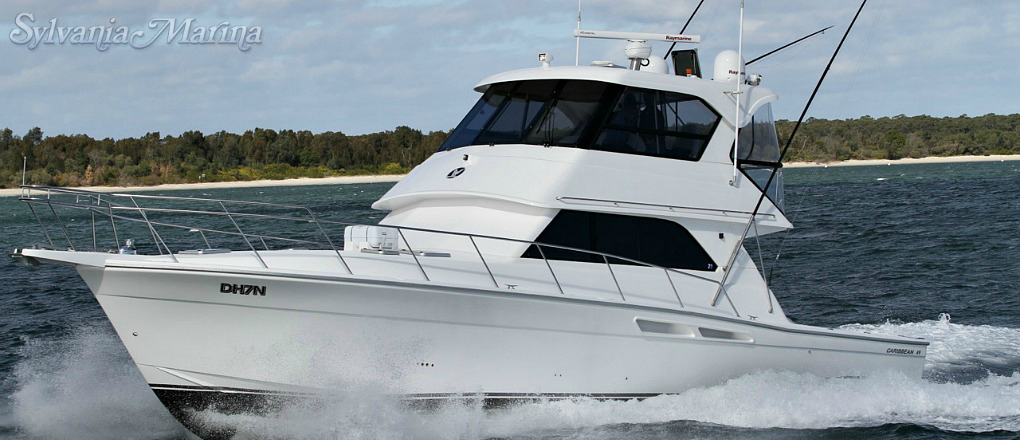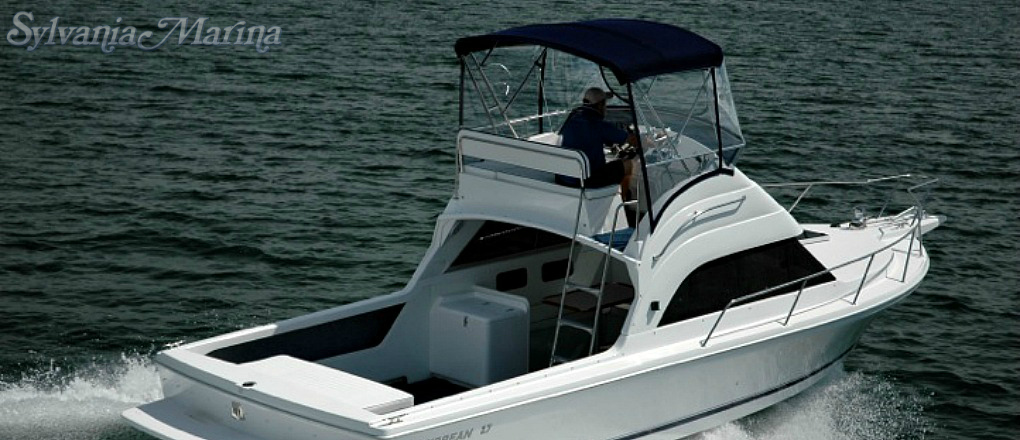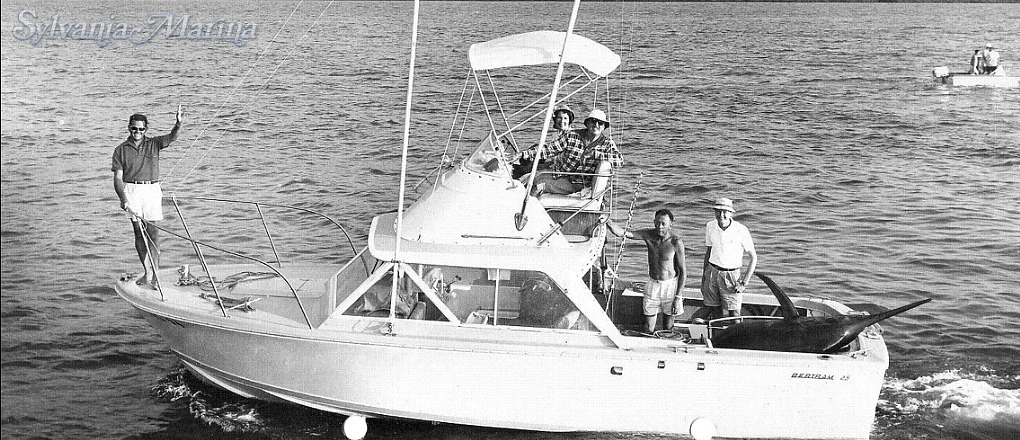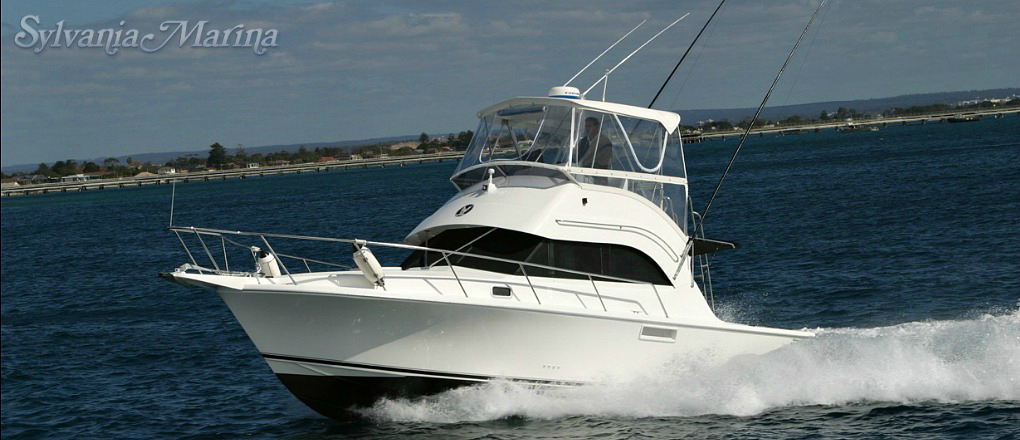2001 Caribbean 2400 Boat Review

Not for me the smell of napalm in the morning. Give me a lung full of salt air any day. There’s nothing quite like the smell of the ocean, baitfish and marlin breath to stir the senses. These ambrosial aromas hung like thick fog in a dairy dale as I ventured into the open ocean.
While it wasn’t exactly morning, it may as well have been. The sea heaved only gently and the sea breeze was fading fast as we rounded Cape Banks and skipped past the boulder they call Shakey. The 100-tonne sandstone tablet shudders when the waves hit it, but not today.
Barely a ripple bounced off the cliffs and I found nothing to upset Caribbean’s new 24-footer. It is the kind of boat that belongs on the ocean. It has a feeling of solidity and a suggestion of success. This latter detail was reflected by the sounder scans of a secret reef just off Shakey.
Bingo! A school of unsuspecting snapper stood out like neon lights on the screen. While we had no fishing tackle, I nevertheless enjoyed my sojourn on Caribbean’s new 24. It’s akin to a modern 4WD family wagon.
That is to say, it is as comfortable running offshore and fishing for marlin as it is snapper. At the same time, you can carry the family around town and, should the need arise, sleep over on full-length bunks.
Built to the sturdy standards for which Caribbean is renown, the new 24-footer presents an interesting mix of potential. The boat comes with a single petrol MerCruiser motor with sterndrive, but there are options for twin outboards.
The boat can be towed at a pinch, though you will need a permit for the 2.7m beam. The layout lends itself to fishing, while being equally at home with the family. Piece it all together and what you have is a boat that doesn’t conform to any particular rule.
No, the Caribbean 24 opens up a new market or niche. A big little boat, the 24 is a pocket cruiser with sporty performance. It’s destined to be kept on a mooring, out of the front of the waterfront home, ideally in a dry stack. And it’s destined to go to sea.
STRONG-ARM TACTICS
International Marine was founded many decades ago. Building Caribbean and heretofore tagged Bertram boats, the Melbourne-based firm built its reputation on the more-is-better philosophy. The early Bertrams were completely overbuilt.
Today’s Caribbeans are a shade lighter but still as solid as any rock but Shakey. No high-tech, mung-bean construction here. Solid hand-laid glass forms the meat below the decks. When I stepped aboard the 24 tied to the marina, fronting the wind and some bay chop, the hull didn’t dip like a lightweight.
Instead, the 24 sits in the water like a half-full bottle of plonk. It rocks ever-so-gently from side to side. The sense of solidity can be attributed to the boat’s beam as well as its robust construction.
If 2.7m works better with a 24ft hull than 2.5m then why not forget the trailerable limits and create a boat that performs on the water where it matters most. At least this is Caribbean’s thinking. The conservative approach is reflected by the upright windscreen with an almost overbearing aluminium frame, the cabin windows that are passe perspex polygons, and the upholstery…
Yet, Caribbean has introduced some surprisingly modern touches to its 24. The styling enhancements are evident in the mouldings. There is a curvaceous fibreglass sheerline, a modern moulded walk-through transom, sculpturing in the internal fibreglass liner, and a flash dash, plus solid stainless deck gear, through-bolted rails and cleats, and a big-boat anchoring arrangement including a solid sprit and windlass.
Appearance-wise, the Caribbean 24 is the company’s most modern boat yet. It could be made more sexy by replacing the cabin windows with anodised-alloy framed oval ports and perhaps changing the windscreen, though I must admit it works where it counts most. So, too, the cockpit.
TAKING THE FLOOR
The 24 is nothing if not big on cockpit space. No, make that huge on cockpit space. The 2.7m beam and compact cabin layout result in as much as two-thirds of the boat being given over to cockpit. Game and sportsfishermen will be inspired by this. I was.
Not surprisingly most of the 24s that have hit the water have fallen into the waiting hands of anglers. Some, like the boat I drove, had outriggers fitted, extra heavy-duty rodholders, and deepwater electronics.
I also sniffed an air of fish. Only the day before, the owner of the 24 had bagged two nice mako sharks. Was that blood in the bilge?
Despite having an inboard, the engine box on the 24 doesn’t exactly overrun the cockpit. Well insulated, the box is fitted with an upholstered top attached with press studs. Access to the transom corners is via upholstered lift-up ply flaps, which are now fashioned from a kind of hard-wearing plastic called starboard. This should prevent the wear-and-tear from opening the flaps that was evident on the testboat.
The protected transom quarter harbours the boat’s batteries, oil bottles if you fit outboards, and pump for the deck shower.
The deck hose/shower will be moved to the sidepocket on future 24s. It was fiddly accessing the pump as it was. You had to unclip the cockpit carpet, pop the press studs on the engine box cover, and feed the hose for the deck shower back behind the flap when you had finished.
Anyway, the transom has a full-length moulded boarding platform with integrated central bait box that works quite well. The bait box is big enough to hold four to six blocks of pilchards, a spread of lures on coiled-up traces, some tracing gloves, wire cutters and knives. There is a small opening door to port that might help you drag a fish aboard if not take on crew before you set out for the day.
As with most Caribbean boats, there were maximum-duty recessed cleats, integrated grabrails recessed in super-wide gunwales, plus four heavy-duty rodholders.
The gunwales, which flare amidships, can double as impromptu bumrests. The flare also provides space for the sidepockets below and support for your thighs.
Big sidepockets run the full-length of the cockpit and include tricky rod or gaff racks that can each take three outfits. Padded rear coamings flank the engine box. And you can lean into the sides of the cockpit while locking your toes under the sidepockets.
The self-draining, non-skid floor offers excellent footing with or without clip-in carpet. I found the scupper system to work brilliantly, however the small aqueducts moulded into the peripheries of the cockpit will still see a lot of water fall into the bilge below the inboard.
Below the floor of the 24 is a veritable chasm of storage. The impressive 350lt fueltank sits amidships. Just forward is a hold that can be used to keep bait or drinks or both on ice. It drains into the bilge. A deck filler is alongside for the freshwater tank, which holds an estimated 150lt.
Between the helm seats is an underfloor well that is truly massive. It could be around 200lt capacity. Add some ice, make a slurry, and you can keep any number of big snapper or dressed 40kg yellowfin in perfect shape. The well also drains into the bilge.
Overhead is a stainless rocket launcher made from extra-thick stainless tubing. A conventional canopy with zip-out section was attached to it and the windscreen. Because of the high windscreen, there is standing room beneath the canopy and a good view when travelling. A bimini top with clears would look more chic.
There’s sufficient sidedeck next to the cabin to allow you to access the foredeck. Or you can pop your body out through the cabin hatch, which rests thoughtfully on stoppers. With a windlass or electric anchor winch there’s not a great need to be on the foredeck. A split bowrail, solid sprit, heavy-duty cleats, and separate rope and chain wells come standard.
GROOVY MOULDINGS
Still more storage can be found around the helm. The pedestal seats are mounted on seat boxes with aft-facing pews on which crew can ride in calm seas. These boxes are useful for storing hardware, tools and emergency supplies. I’d add a flush-mount tackle box or two as well.
Storage for personals exists in split-level sidepockets alongside the helm seats and in the cabin.
Naturally, the wide-beam 24 has a wonderfully wide helm. There is plenty of space between the seats for a third person to stand while running to sea. There are no grabrails, however, and a rail along the edge of the windscreen wouldn’t go astray.
A groovy moulded dash with mock-walnut brow signifies that Caribbean can cut it with the best fibreglass moulders. Driving positions worked whether standing or seated. You have a footrest and adjustable seat, sturdy stainless wheel, and a throttle box alongside.
The windscreen mightn’t be too stylish, but it is functional. Dual wipers help clear the spray from the lightly tinted four-piece screen. It’s made of armourglass and an overbuilt frame that will stay put for years to come.
A spread of electronics graced the dash, with plenty of room left over for more. There were GME radios and stereo, a Furuno GPS and handy LCD sounder.
The walnut brow harboured white-rimmed MerCruiser gauges – volts, speed, engine temp, oil, trim, rpm, and fuel – alongside were switch panels for the lights including cockpit floor lights.
OFFSHORE & OVERNIGHT
While the 24’s cockpit dominates the boat, its lock-up cabin is surprisingly roomy. The V-berth is big enough for two adults to sleep with as much comfort as they can on any V-berth. The cabin is fully lined, flanked by sidepockets, and with yet more storage under the bunks.
A manual toilet is fitted to the boat, though there isn’t provision for a holding tank.
Add all the pieces together and a good all-round offshore rig emerges. I could see myself owning a Caribbean 24 on the strength of its layout alone. While the transom styling isn’t to my personal tastes, I would no doubt get used to it. More the point, the boat works for gamefishing in summer, snapper in winter, and some playful runs with the family in between.
Of course, none of it would count for much if the new 24 didn’t cut it at sea. Weighing in the boat’s favour is a hull that is heavy enough to sit down and cut through the sea. Working against this is a boat with a fuller entry than older-style Caribbeans.
I’m told it was derived from the original 24.
Whatever the case, we bounded north along the cliffs over a lazy swell and the boat brushed off the seas like a rhino might a fly on its tail. At optimum cruise speeds it seems to travel sweetly.
At 3000rpm, we trounced along at a lovely 21.5kt. The dealer and I were sharing fish stories, talking about snapper-catching tactics, and saying our prayers for a good gamefishing season ahead. The 24 will cruise all day at such speeds with an inherently level trim, without dragging or burying its transom, and without being too noisy.
At 3400rpm, the MerCruiser had the boat doing 24.4kt on the GPS. Top speed was 31.5kt, but with fuel prices the way they are, your wallet and the boat’s cruising range will suffer at the hands of a hard-revving V-eight.
At cruise speeds and while trolling, the motor should be quite economical to run. A day’s fishing should see you come in using less that 200lt.
Fitted with a Bravo II sterndive, the boat exhibited a good holeshot, an ability to hold low planing speeds, and a degree of a manoeuvrability to assure any tin-pot trailerboat angler.
Having said that, a 24 with twin direct-injection two-strokes, the Mercury motors with the Orbital system, appeals to me. Especially if the boat would plane on one motor. Such outboards should lead to low maintenance and fuel bills of perhaps $100 or less a day.
Like a whiff of salt air in the morning, the Caribbean 24 is a refreshing boat. It blends olde-worlde values with new-world charm. It has enough room to give the illusion of being a big boat, but the handling and agility to throw around.
By my reckoning, the 24 will open people’s eyes to a new realm of mini cruisers. After all, its people on boats like this are seen at weighstations bringing home thousand-pound tigers and winning competitions with blue marlin. As I said, the promise of such things hung in the air…
| CARIBBEAN 24 |
| PRICE AS TESTED $80,000 |
| OPTIONS FITTED |
| Dealer options from Sylvania Marina include rodholders, electronics, outriggers, clip-in cockpit carpets, rocket launcher, canvas, antifouling, etc. |
| PRICED FROM $72,345 (with 260hp EFI MerCruiser) |
| GENERAL |
| Material: GRP |
| Type: Deep-vee mono |
| Length (overall): 7.20m |
| Beam: 2.70m |
| Draft: not given |
| Deadrise at transom: n/a |
| Displacement: 8500kg |
| CAPACITIES |
| Berths: not given |
| Fuel capacity: 350lt |
| Water capacity: 150lt |
| ENGINE (AS TESTED) |
| Make/Model: MerCruiser |
| Type: Electronic fuel-injected petrol V-eight four-stroke |
| Rated hp: 260hp |
| Displacement: 5.7lt |
| Weight: 572kg |
| Gearbox (make/ratio): Bravo II |
| Props: Four-blade stainless |
| TESTBOAT SUPPLIED BY Sylvania Marine, Sylvania (NSW), tel (02) 9522 7430. |
**Review written 2001







Connect With Us